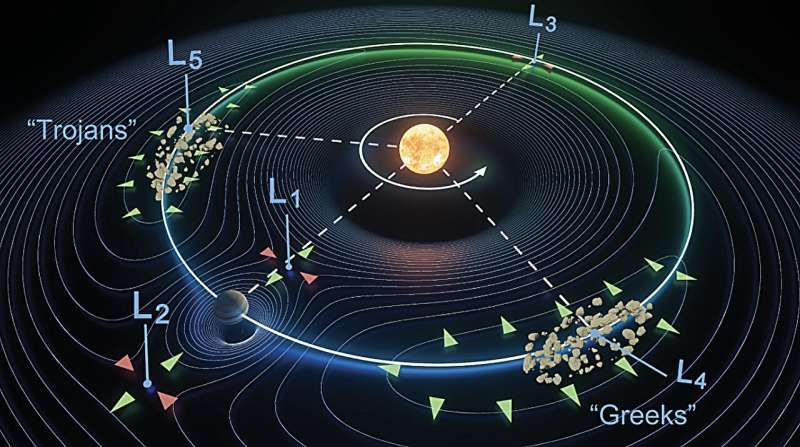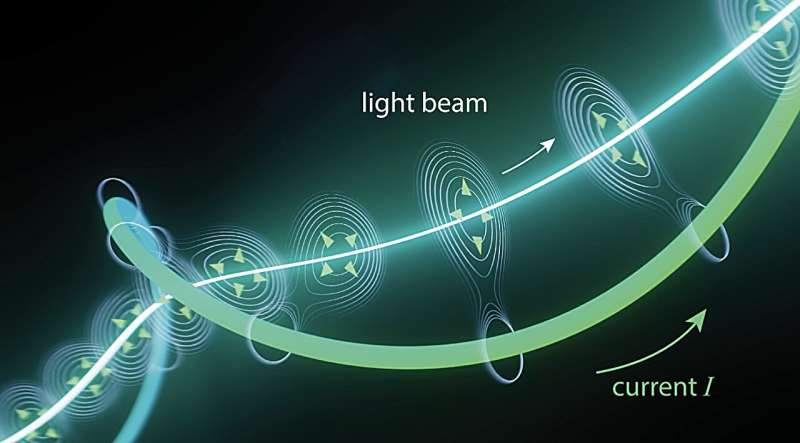January 30, 2024 feature
This article has been reviewed according to Science X's editorial process and policies. Editors have highlighted the following attributes while ensuring the content's credibility:
fact-checked
peer-reviewed publication
trusted source
proofread
A Trojan approach to guide and trap light beams via Lagrange points

Reliably guiding and capturing optical waves is central to the functioning of various contemporary technologies, including communication and information processing systems. The most conventional approach to guide light waves leverages the total internal reflection of optical fibers and other similar structures, yet recently physicists have been exploring the potential of techniques based on other physical mechanisms.
Researchers at University of Southern California recently devised a highly innovative approach for trapping light. This method, introduced in Nature Physics, exploits the exotic properties of Lagrange points, the same equilibrium points that govern the orbits of primordial celestial bodies, such as so-called Trojan asteroids in the sun-Jupiter system.
"The discovery of Lagrange points, which happens to be pivotal in this research, can be traced back to the early work of Leonhard Euler and Joseph-Louis Lagrange, which found that at these locations, the gravitational attraction exerted by two large bodies can be precisely counterbalanced by centrifugal forces," Mercedeh Khajavikhan and Demetrios N. Christodoulides, co-authors of the paper, told Phys.org.
"While some of these points, notably and, are already employed as strategic positions in space for satellite stability with minimal propellant consumption (as exemplified by the James Webb telescope and the recently deployed Aditya L1 satellite), our study focuses on the intriguing properties of and Lagrange points."
Trojan asteroids are a large group of asteroids circling the sun on the same orbit as the planet Jupiter. Lagrange points, named after the renowned mathematician Lagrange who uncovered them, are positions in space in which the gravitational force of two bodies in the same system (e.g., the sun and Jupiter) produce enhanced regions of attraction and repulsion.
As part of their study, Khajavikhan and Christodoulides set out to investigate the potential of utilizing the unique physics of these positions to guide and trap light waves. In their paper, the researchers showed that the use of and Lagrange points for optical applications in some ways resembles capturing Trojan asteroids within the sun-Jupiter orbit.
"The Lagrange optical waveguide is induced by passing current through a helical wire in a cured silicon oil cylinder," Khajavikhan and Christodoulides said.
"By means of the thermo-optic effect, this in turn produces a twisted index landscape where in this case, the photon repulsion is balanced by the centrifugal force. Counterintuitively, in this mountain-slope index profile, a stable Lagrange point, is produced and as a result, a Trojan optical beam is trapped in a two-dimensional fashion at this position."
As part of their study, Khajavikhan and Christodoulides created a compact system in their laboratory reproducing the properties of Lagrange points, such as those observed in the orbits of Trojan asteroids. Their laboratory-built system was comprised of a helically-shaped iron wire inserted in a medium with a temperature-dependent refractive index.

The researchers could later heat this medium in a non-homogeneous way by passing electricity through the wire. Ultimately, this process enabled the formation of what they refer to as a Trojan optical beam.
This simple experiment led to very interesting observations. Interestingly, the researchers found that optical Trojan beams could be guided or captured in this defocusing refractive index environment, something that is not feasible under normal circumstances.
"More importantly, the refractive index landscape where these optical beams are captured is completely unremarkable, having no features whatsoever that could foretell a guiding response," Khajavikhan and Christodoulides said. "In essence, the optical beam is trapped in a nowhere land—in completely inconspicuous regions where no conventional waveguide structures exist."
The recent work by this team of researchers shows the unique characteristics of Lagrange points can be leveraged to guide and trap light waves. In the future, it could form the development of new techniques to guide optical waves in unconventional environments when conventional approaches are ineffective, such as in liquids and gases.
"A possible avenue for further exploration could be the use of Trojan beams in amplifying (laser) systems, where optical gain or loss can establish alternative means for beam attraction or repulsion in fully dielectric media," Khajavikhan and Christodoulides said.
So far, the researchers have only focused on the use of Lagrange points for guiding light beams. However, in the future the methodology they developed could also be tested in other areas of physics reaching beyond optics, for instance as a technique to guide acoustic waves or ultracold atoms.
"At this point, we plan to explore the possibility of guiding light in acoustic waves in both liquid and gaseous media," Khajavikhan and Christodoulides added. "Finally, of interest would be to observe for the first-time trapping and transporting dielectric micro- and nano-particles in Lagrange waveguides using optical tractor beams where multiple Lagrange points can be induced—an aspect that is not possible in celestial mechanics."
More information: Haokun Luo et al, Guiding Trojan light beams via Lagrange points, Nature Physics (2024). DOI: 10.1038/s41567-023-02270-6
Journal information: Nature Physics
© 2024 Science X Network





















